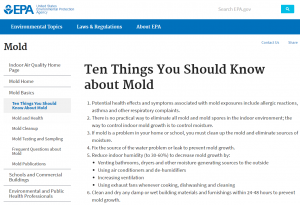
These ten things you should know about mold come from the United States Environmental Protection Agency (EPA) and can be found here. At Dutch’s Mold Inspections & Mold Remediation Services it is not our goal to simply remove mold, but to address the issues that caused the mold. You’ll notice in the EPA’s list many references to moisture build-up, leaks, ventilation and insulation. When you call us, our decades of experience as a home inspection company, previous careers in the building industry and specialized focus in mold remediation and indoor air quality makes us uniquely qualified to diagnose and address the ventilation, moisture and air-flow issues in your home.
Mold Causes Allergic Reactions & Respiratory Issues
Control Mold by Controlling Moisture
2. There is no practical way to eliminate all mold and mold spores in the indoor environment; the way to control indoor mold growth is to control moisture.
Remove Existing Mold & Eliminate Moisture Source or Water Leaks
3. If mold is a problem in your home or school, you must clean up the mold and eliminate sources of moisture.
4. Fix the source of the water problem or leak to prevent mold growth.
Proper Ventilation is the Key to Indoor Humidity and Mold
5. Reduce indoor humidity (to 30-60%) to decrease mold growth by:
- Venting bathrooms, dryers and other moisture-generating sources to the outside
- Using air conditioners and de-humidifiers
- Increasing ventilation
- Using exhaust fans whenever cooking, dishwashing and cleaning
Mold Clean-Up & Mold Removal
6. Clean and dry any damp or wet building materials and furnishings within 24-48 hours to prevent mold growth.
7. Clean mold off hard surfaces with water and detergent, and dry completely. Absorbent materials such as ceiling tiles, that are moldy, may need to be replaced.
Address Condensation & Don’t Use Carpet Near Moisture Problems
8. Prevent condensation: Reduce the potential for condensation on cold surfaces (i.e., windows, piping, exterior walls, roof, or floors) by adding insulation.
9. In areas where there is a perpetual moisture problem, do not install carpeting (i.e., by drinking fountains, by classroom sinks, or on concrete floors with leaks or frequent condensation).
Mold Can Grow Anywhere that Moisture is Present
10. Molds can be found almost anywhere; they can grow on virtually any substance, providing moisture is present. There are molds that can grow on wood, paper, carpet, and foods.
